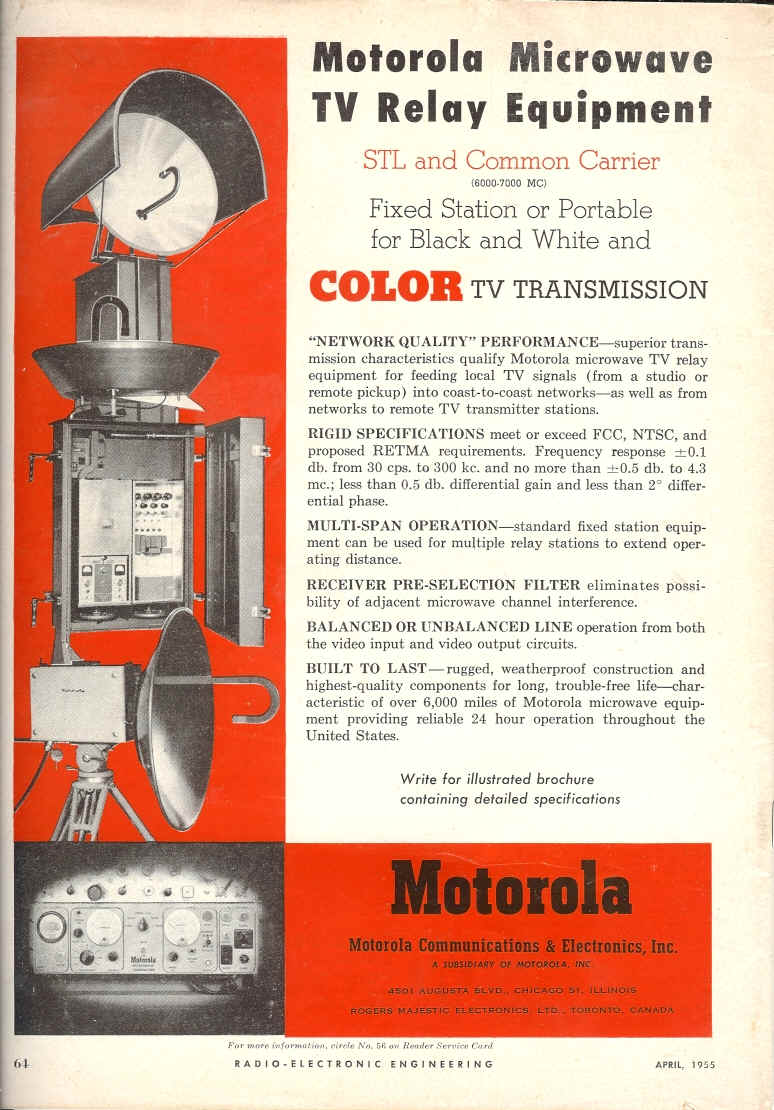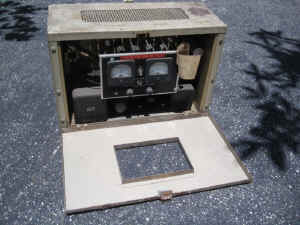| Hi Ed, I found this - Freq 1 Lower: 12737.5000 MHz Freq 1 Upper: 12762.5000 MHz Freq 1 EIRP: 45.7 dBm Freq 1 Emission: 25M0F8W Transmitter Manufacturer: Microwave Associates Transmitter Model: MA-13CP Station Class: Operational Fixed Constructed: 11/03/2004 From here - http://www.fccinfo.com/CMDProULSLookup.php?tabSearchType=UMIB&tabTextBox1=2535349 And here -http://uweb.txstate.edu/~me04/projectx.htm The Beginning of the ENG Revolution Excerpt - "The cable, though, was soon replaced by a microwave link using a small transmitter (model MA-13CP) manufactured by Microwave Associates of Burlington, MA." Jerry |
|
Harris bought M/A Com in 2009, IIRC.
When ENG trucks were a relatively new tool in the news gathering
arsenal, (late 70's early 80's) M/A 13GHz "shoebox" microwave
links were pretty common on each truck. Usually with a horn antenna on
the TX and RX. They aren't as directional as a dish, so you didn't have
to be quite so picky about having the both pointed directly at each
other on a straight line.
The Shoebox units allow setting the camera where it was desired, and the
truck where it could hit the ENG receiver. The shoebox link would
provide the video and audio path when a cable-reel run wasn't really feasible.
This was before a lot of stations had developed a plethora of receive
sites, so getting the truck parked where it could hit one of the/the
only ENG receiver was one of the keys to getting a live shot to work.
Here's an interesting article about 1978-era ENG in an Oct. '78
Popular Mechanics. Begins on page 220.
The shoebox units are mentioned on Page 226, after a description
of the 2GHz units worked.
Seems to me that Tim Stoffel and I were just talking about 13GHz links
last week... and if I recall correctly, he was telling me it's become
very difficult to use them due to licensing and siting issues.
In the US, the 2GHz Broadcast Auxiliary Service (BAS) bandwidth and some
other fixed microwave services were shuffled under Part 74.690 of the
rules, so Advanced Wireless and Mobile Satellite Services could use some
of the spectrum. Cell phone carrier Nextel (now part of Sprint)
paid to provide new gear to stations in order to get access to
their former spectrum.
Licensing and operation of BAS and television remote pickup stations is
covered under Part 74.600 of the FCC Rules.
Here's the 2009 PDF version that the FCC's website page on Microwave
services links to.
Check to see if there's a 2010 or 2011 version.
Ed: If you own one of these 13GHz units, and have ideas about
using it in your news gathering activities, you might check to see what
kind of status you have. Could you qualify as a license as a broadcast
network? Or as a common carrier providing Local Television
Transmission, as mentioned in Part 74.602, 4, e:
(e) Communication
common carriers in the Local Television Transmission Service (Part
101) may be assigned frequencies
available to television broadcast station licensees and broadcast network
entities for the purpose of providing service to television
broadcast
stations and broadcast network entities, respectively.
That's covered here:
and found in the rules under Unde r Subpart J, which begins at SS
101.801. That's on page 771 of the PDF linked here:
|
| SMECC Needs 1940s 50s Television Microwave Relay
equipment
Please email us at info@smecc.org
|
|
DAGE - Sarkes Tarizan microwave receiver
We have this Sarkes Tarizan microwave receiver
at the SMECC Museum. We
NEED MORE INFO AND.... WE WANT THE CAMERA AND BACKPACK!
|
|
Deciphering the linage of some microwave communication companies.
Deciphering the linage of some microwave communication companies. We would like to have various people familiar with each companies history take a section of this and flesh it out a bit for the web site here. http://www.fundinguniverse.com/company-histories/Cohu-Inc-Company-History.html
Some Key Dates In the Tayburn/BMS/Cohu Linage:1931 : Fisher Research Laboratory is founded. 1947 : Kalbfell Laboratories is founded. 1957 : Lamott T. Cohu buys the company, which reincorporates as Cohu Electronics Inc.; Delta Design is founded. 1959 : Daymarc Corporation is founded. 1967 : Cohu acquires Fisher Research. 1970's: Tayburn (need to add more... as little is covered in the COHU History Document) 1982 : Broadcast Microwave Services is founded. 1983 : Cohu acquires Delta Design. 1984 : Cohu acquires Broadcast Microwave. 1994 : Cohu acquires Daymarc.
One passage that directly affects us here is the follow brief statement. "Broadcast Microwave Services, Inc. was founded in 1982 by a group of former Tayburn, Inc. employees to develop and market microwave products for video transmission. Two years later, the company was purchased by and became a wholly owned subsidiary of Cohu Inc. "
http://www.fundinguniverse.com/company-histories/Cohu-Inc-Company-History.html
Keywords references in the above article link - note if this link
goes dead please let me know at the email address below.
Cohu, Inc., Dr. David Kalbfell, Kalbfell Laboratories, Inc., Kay Lab, Lamott T. Cohu , Cohu Electronics Inc. , Cohu, Inc., Dr. Gerhard Fisher, Federal Telegraph Corporation, Kloster, radio direction finder, tayburn, Fisher Research Laboratory, Metallascope, M-Scope, 745 Emerson Street, Palo Alto, Belmont, California, Delta Design, Daymarc, Corporation, Broadcast Microwave Services, Inc., Cohu Inc. Electronics Division, Daymarc Corp, Delta Design, Inc., Fisher Research Laboratory Inc.
|
|
Be sure to see our section on the Bell
Labs
|





